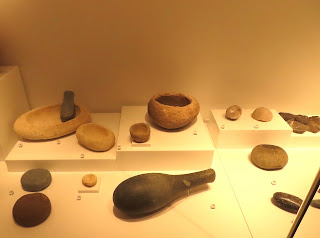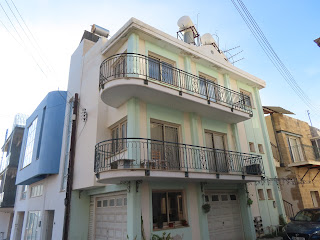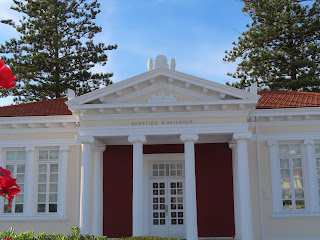We had a great visit to the Archeological Museum of Paphos. They had some of the oldest artifacts we have seen so far, amulets from 3500 BCE and stone tools from 3900 BCE. The amulets were carved out of picrolite a waxy green stone that is found on the island. This was a compact museum that was renovated fairy recently and the layout was thoughtful and the displays were very accessible. We have seen the opposite where informational placards were unreadable due to poor lighting or obscure fonts and glass cases that had so much glare that the item within was obscured. None of that here! The arrangement was chronological, from neolithic stone age, to iron age to bronze age to the Hellenistic period, the Ptolemaic period and finally the Romans. As one would expect the artifacts get more and more refined and grand as time progresses with the exception of the very earliest pieces, the amulets mentioned above. Then it was off to some much anticipated sushi and a stroll around the old town. The funny thing about the old town was it was a recent kind of old. There were no ancient ruins but some stately homes and buildings from the 1800's. All the old old town is under the new old town.
We were surprised to see this man on the rocks. He must have had to scramble over large rocks and some semi submerged areas to get to where we stood
The admission was free
A large and inviting space
A diagram of the items found while excavating a 30 meter deep well. Bones, stone tools, beads and shells tell a rich history of the pre historic people.
The craftmanship and details of these amulets was amazing
6000 years ago someone was crafting this with very rudimentary tools
Art and spirituality are tied together throughout time
The is one big granite pestle!
Stone adzes from 4000 BCE ago
A seal ring from 2000 BCE
Cyprus was a major supplier of copper and this shows the smelting process
A cylinder seal from 1650 BCE
A whole household worth of goods
Goats, birds and triple jars from the 11th century BCE
The artistry was top notch
This is a statue of Geryon a giant with three bodies! He had three heads and three sets of legs attached at the waist. Geryon was the grandson of Medusa. Apparently when Medusa was beheaded by Perseus, Cryselor sprang from her body and later Cryselor fathered Geryon. He has a legendary herd of cattle on an island by Gibraltar that Hercules was tasked with stealing. The herd was guarded by a two headed dog, Orthus. This dog was from the same litter as the more famous Cerberus the three headed dog at the gates of hell. True to his brutish ways Hercules kills Geryon and Orthus the dog then snatches the entire herd of cattle.
A mold for making blanks for coins
A hoard of coins from Alexander the Great and his pops Phillip IV, 4th century BCE
The graphic on the wall shows how these amphorae would be stacked in a ship
We have reached the Roman area, Aphrodite is shown here
It is our man Hercules again. Here is is on a bender with the cherubs, known drunkards
Novelty cups were a thing even back then
Various lamps include this Satyr lamp who was described as deformed
The Roman glass is very special
One big limestone lion only for the finest citizens
Perfectly preserved marble statue
From the 1st century BCE Paphos shows evidence of becoming a center of healing.
Folks came from all around the Mediterranean for the healing. These are ceramic hot water bottles
Anyone need a hand? The bottles were ceramic and the walls were only 3mm thick. The thinness allowed the heat from the hot water or hot oil to transfer through the ceramic
They were shaped in the form of the body part that they were intended to be used upon
Making limestone sarcophagi was a local industry
Many funerary statues were made here as well
Sushi!
Some salmon
Duck dumplings and a fancy roll
Funny video game themed bathroom door sighn
Not obligatory perhaps, but present
Funny sign
A new plant, thick leaves to keep the moisture in and bright green
A stately "oldish" home
A statue commemorating the Greeks who helped stop the Turks
Love the balcony
Big wall for a small gate
A large cemetery off in the distance
A grand gateway into a mediocre park
Some civic buildings were here as well
Of course the real old town is under the new old town
Glass art
I wonder that the knobs on the edges were for?
Happy Holidays
A ramma-gramophone
What might this story be?





















































